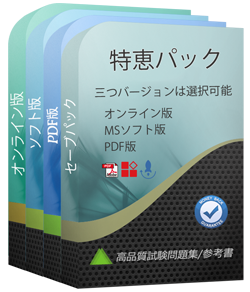あなたは70-516試験参考書の更新をどのぐらいでリリースしていますか?
すべての試験参考書は常に更新されますが、固定日付には更新されません。弊社の専門チームは、試験のアップデートに十分の注意を払い、彼らは常にそれに応じて70-516試験内容をアップグレードします。
Tech4Examはどんな試験参考書を提供していますか?
テストエンジン:70-516試験試験エンジンは、あなた自身のデバイスにダウンロードして運行できます。インタラクティブでシミュレートされた環境でテストを行います。
PDF(テストエンジンのコピー):内容はテストエンジンと同じで、印刷をサポートしています。
70-516テストエンジンはどのシステムに適用しますか?
オンラインテストエンジンは、WEBブラウザをベースとしたソフトウェアなので、Windows / Mac / Android / iOSなどをサポートできます。どんな電設備でも使用でき、自己ペースで練習できます。オンラインテストエンジンはオフラインの練習をサポートしていますが、前提条件は初めてインターネットで実行することです。
ソフトテストエンジンは、Java環境で運行するWindowsシステムに適用して、複数のコンピュータにインストールすることができます。
PDF版は、Adobe ReaderやFoxit Reader、Google Docsなどの読書ツールに読むことができます。
あなたのテストエンジンはどのように実行しますか?
あなたのPCにダウンロードしてインストールすると、Microsoft 70-516テスト問題を練習し、'練習試験'と '仮想試験'2つの異なるオプションを使用してあなたの質問と回答を確認することができます。
仮想試験 - 時間制限付きに試験問題で自分自身をテストします。
練習試験 - 試験問題を1つ1つレビューし、正解をビューします。
割引はありますか?
我々社は顧客にいくつかの割引を提供します。 特恵には制限はありません。 弊社のサイトで定期的にチェックしてクーポンを入手することができます。
購入後、どれくらい70-516試験参考書を入手できますか?
あなたは5-10分以内にMicrosoft 70-516試験参考書を付くメールを受信します。そして即時ダウンロードして勉強します。購入後に70-516試験参考書を入手しないなら、すぐにメールでお問い合わせください。
更新された70-516試験参考書を得ることができ、取得方法?
はい、購入後に1年間の無料アップデートを享受できます。更新があれば、私たちのシステムは更新された70-516試験参考書をあなたのメールボックスに自動的に送ります。
返金するポリシーはありますか? 失敗した場合、どうすれば返金できますか?
はい。弊社はあなたが我々の練習問題を使用して試験に合格しないと全額返金を保証します。返金プロセスは非常に簡単です:購入日から60日以内に不合格成績書を弊社に送っていいです。弊社は成績書を確認した後で、返金を行います。お金は7日以内に支払い口座に戻ります。
Microsoft TS: Accessing Data with Microsoft .NET Framework 4 認定 70-516 試験問題:
1. You use Microsoft Visual Studio 2010 and Microsoft .NET Framework 4.0 to create an application.
The application uses the ADO.NET Entity Framework to model entities.
The application allows users to make changes to entities while disconnected from the central data store.
You need to ensure that when the user connects to the central data store and retrieves new data, the application meets the following requirements:
-Changes made to the local data store in disconnected mode are preserved.
-Entities that have already been loaded into the local data store, but have not been modified by the user,
are updated with the latest data. What should you do?
A) Call the query's Execute method by using the MergeOptions.AppendOnly option.
B) Call the Refresh method of ObjectContext by using the RefreshMode.StoreWins option.
C) Call the query's Execute method by using the MergeOptions.OverwriteChanges option.
D) Call the Refresh method of ObjectContext by using the RefreshMode.ClientWins option.
2. The database contains a table named Categories. The Categories table has a primary key identity column
named CategoryID.
The application inserts new records by using the following stored procedure.
CREATE PROCEDURE dbo.InsertCategory @CategoryName nvarchar(15), @Identity int OUT
AS INSERT INTO Categories (CategoryName) VALUES(@CategoryName) SET @Identity = SCOPE_IDENTITY() RETURN @@ROWCOUNT
You write the following code segment.
SqlDataAdapter adapter = new SqlDataAdapter("SELECT categoryID, CategoryName
FROM dbo.Categories",connection);
adapter.InsertCommand = new SqlCommand("dbo.InsertCategory", connection);
adapter.InsertCommand.CommandType = commandType.StoredProcedure;
adapter.InsertCommand.Parameters.Add(new SqlParameter("@CategoryName",
SqlDbType.NVarChar, 15,"CategoryName"));
You need to retrieve the identity value for the newly created record. Which code segment should you add?
A) SqlParameter parameter = adapter.InsertCommand.Parameters.Add("@CategoryName", SqlDbType.Int); parameter.Direction = ParameterDirection.Output; parameter = adapter.InsertCommand.Parameters.Add("@Identity", SqlDbType.Int, 0, "CategoryID"); parameter.Direction = ParameterDirection.Output;
B) SqlParameter parameter = adapter.InsertCommand.Parameters.Add("@CategoryName", SqlDbType.Int); parameter.Direction = ParameterDirection.Output; parameter = adapter.InsertCommand.Parameters.Add("@Identity", SqlDbType.Int, 0, "CategoryID"); parameter.Direction = ParameterDirection.ReturnValue;
C) SqlParameter parameter = adapter.InsertCommand.Parameters.Add("@RowCount", SqlDbType.Int); parameter.Direction = ParameterDirection.ReturnValue; parameter = adapter.InsertCommand.Parameters.Add("@Identity", SqlDbType.Int, 0, "CategoryID"); parameter.Direction = ParameterDirection.Output;
D) SqlParameter parameter = adapter.InsertCommand.Parameters.Add("@RowCount", SqlDbType.Int);
parameter.Direction = ParameterDirection.Output;
parameter = adapter.InsertCommand.Parameters.Add("@Identity", SqlDbType.Int, 0, "CategoryID");
parameter.Direction = ParameterDirection.ReturnValue;
3. You use Microsoft Visual Studio 2010 and Microsoft .NET Framework 4.0 to create a Windows Communication Foundation (WCF) Data Services service. The solution contains the projects shown in the following table.
The WCF data service exposes an Entity Framework model. You need to Access the service by using a
WCF Data Services client.
What should you do in the Application.Client Project?
A) Add a service reference that uses the URL of the WCF data service.
B) Add a web reference that uses the URL of the WCF data service.
C) Add a referance to the Application.Model Project.
D) Add a referance to the Application.Service Project.
4. You use Microsoft Visual Studio 2010 and Microsoft .NET Framework 4.0 to create an application.
The application connects to a Microsoft SQL Server database. The application stores user names and
passwords in the database.
You need to ensure that users cannot read passwords extracted from the database. What should you do?
A) Append a random salt to the password by using the RNGCryptoServiceProvider class. Hash stored passwords by using the SHA1CryptoServiceProvider class.
B) Encrypt stored passwords by using the RC2CryptoServiceProvider class.
C) Encrypt stored passwords by using the TripleDESCryptoServiceProvider class.
D) Append a random salt to the password by using the RNGCryptoServiceProvider class. Encrypt stored passwords by using the RijndaelManaged class.
5. You use Microsoft Visual Studio 2010 and Microsoft .NET Framework 4.0 to create an application.
The application connects to a Microsoft SQL Server database.
The Data Definition Language (DDL) script of the database contains the following code segment:
CREATE TABLE [Sales].[SalesOrderHeader]( [SalesOrderID] [int] IDENTITY(1,1) NOT NULL, [BillToAddressID] [int] NOT NULL, ... CONSTRAINT [PK_SalesOrderHeader_SalesOrderID] PRIMARY KEY CLUSTERED ([SalesOrderID] ASC) )
ALTER TABLE [Sales].[SalesOrderHeader] WITH CHECK ADD CONSTRAINT [FK_SalesOrderHeader_Address] FOREIGN KEY([BilIToAddressID]) REFERENCES [Person].[Address]([AddressID])
You create an ADO.NET Entity Framework model. You need to ensure that the entities of the model
correctly map to the DDL of the database.
What should your model contain?

A) Option
B) Option
C) Option
D) Option
質問と回答:
| 質問 # 1 正解: D | 質問 # 2 正解: C | 質問 # 3 正解: A | 質問 # 4 正解: A | 質問 # 5 正解: A |


 弊社は製品に自信を持っており、面倒な製品を提供していません。
弊社は製品に自信を持っており、面倒な製品を提供していません。



 -东て**
-东て**

